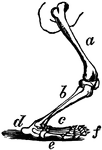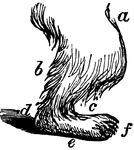Clipart tagged: ‘Polar bear’

Polar Bear
A large white bear that lives in the Arctic regions of North America. They are powerful swimmers and…

Polar Bears on Iceberg
An illustration of two polar bears standing on icebergs with large icebergs surrounding them.

Giant Panda
"Æluropus melanoleucus- A remarkable genus of carnivorous quadrupdes of the arctoid series of the order…

Polar Bear Leg
The polar bear, Plantigrada, is part of the subdivision Carnivora, which includes other carnivorous…

Polar Bear Leg
The anatomy of a polar bear's leg. a, femur (thigh); b, tibia (leg); c, tarsus and metatarsus (foot);…

Wilhelma
The Wilhelma was originally a royal palace, mimicking Moorish architecture. After the second world war,…


